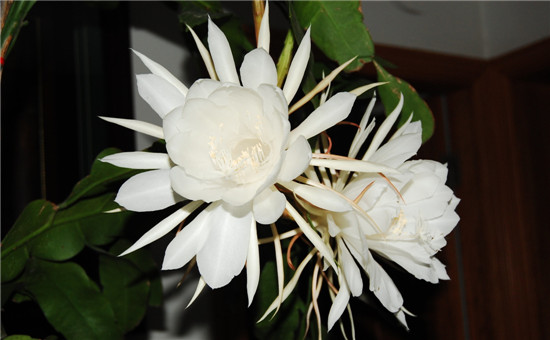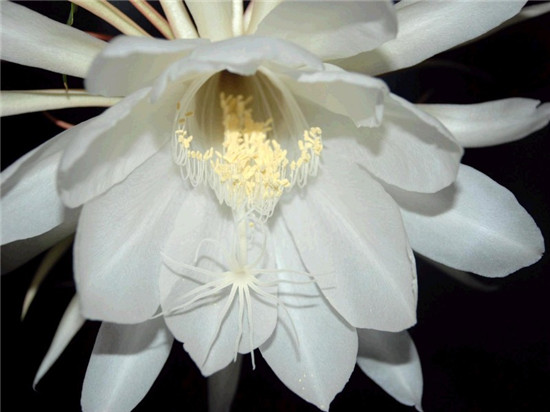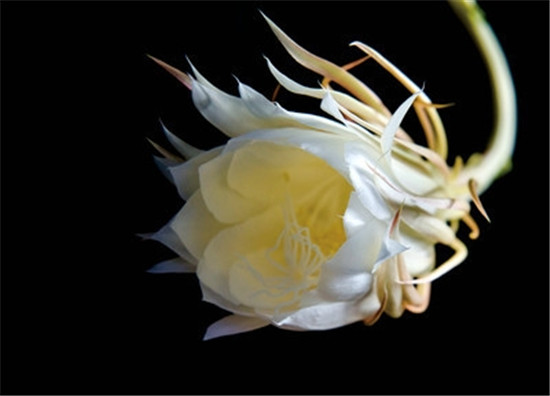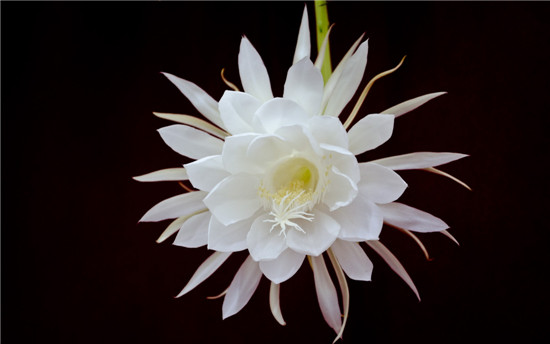[culture methods of epiphyllum] what are the culture methods of epiphyllum
In fact, many people who know about the conversation know that the survival rate of epiphyllum is still very high, so let's take a look at the cultivation methods of epiphyllum.

A flash in the pan, only for Weituo, here is an old story about epiphyllum. Since ancient times, epiphyllum has been given almost magical color. The flowers that bloom only at night are extremely gorgeous and dazzling, but it is a pity that people can only see such beautiful flowers at that moment. For many people, epiphyllum is beautiful, distant as if an unrealistic dream, and therefore, the flower is also more colorful. People like to plant it indoors for viewing. However, epiphyllum is not so easy to grow.
Epiphyllum, also known as Yuexia Beauty, originated in Mexico and other places, is a beautiful ornamental flower. However, its florescence is very short, blooming in the middle of the night, from flowering to withering only 4 hours. It is a kind of flower that likes warm and moist soil, likes semi-shady environment, is not resistant to drought but can withstand high temperature. The tips for epiphyllum culture are as follows:

1. Planting
Generally, the culture soil mixed with garden soil and rotten leaf soil and mixed with a small amount of fine sand is the most suitable soil for epiphyllum to grow. It is better to change the basin every other year, which is better than in the early spring season. When changing the basin, get rid of the decaying roots, remove part of the old soil, and add new nutrient soil.
2. Fertilization
Fertilization is generally 10 days to half a month, based on thin fertilizer, you can add a small amount of rice vinegar to the fertilizer, there will be a more gratifying growth. The flowering period should be fattened, which can be reconciled with 0.2% solution of potassium dihydrogen phosphate. Fertilizers should also be applied after the flowers fade to prepare for the meeting in the coming year.
3. Watering
See dry and wet is an important principle of epiphyllum culture, there must not be stagnant water in the basin. In hot and dry summer, clear water can be sprayed on the leaves, too much water will cause rotten roots, but this method can ensure that there is no stagnant water while replenishing air humidity, which is conducive to growth and flowering in the coming year.
4. Temperature, light
Epiphyllum because like semi-overcast environment, so in spring and summer should pay attention to sunscreen, put indoor culture, and pay attention to light intensity, avoid exposure. In addition, epiphyllum should be placed in a ventilated place, such as a window. The room temperature should be kept at about 10 ℃, and the soil moisture should be controlled, not too dry or too wet.

5. Reproduction
Epiphyllum is often sown or cut in the breeding season. The growth of the sowing method is slow, and the flowering season is delayed, so the planting method is often used. The simple and easy insertion method can greatly shorten the flowering time, but attention should be paid to the selection of cuttings. Generally speaking, it is better to grow full and strong stems and leaves, but it is not suitable for being too old or too tender. The cuttings will be cut into small segments, ventilated and dried, and then inserted into the soil after the cut is air-dried. The soil should be loose and moist, and the temperature should be controlled at 18-25 ℃. After rooting, the cuttings should be moved into the basin for cultivation.
6. Florescence regulation
Although epiphyllum is beautiful, it is a pity that it always opens at night, so there is only a flash in the pan, only for Weituo's view, while epiphyllum blossoms after 9 o'clock in the evening and is easy to wither, so is there any way to change this state?
The steps of insertion and propagation of epiphyllum:
1. Choose a healthy leaf, or choose a 1-2-year-old strong, thick stem as cuttings, preferably a slightly longer one, and cut it off with scissors.
2. Cut the leaves into several segments according to the demand, with a length of 10ml and 15m.
3. Put it in a place where the sun will not be exposed directly and wait for the cut to dry and let it dry for 3 days.
4. After the cut is dry, insert it into a tile basin filled with vermiculite or plain sand (or find soil that is not too wet), place it in the shade, keep it 18 ℃ 24 ℃, and bury the cut into the soil 1-2cm.
5. Don't water the soil often, make the soil a little drier, and if it dries badly, water less. Spray a little water every 4 days, often insert the substrate semi-moist, take root about 4 weeks after insertion, can be moved to the place of low light, pay attention to spray water, put on the pot when the root is 4 meters long.
6. Wait 2-3 weeks, and you should be able to take root.

Note: epiphyllum is dormant in winter. Watering should be controlled and fertilizer should be stopped to make the basin soil slightly dry. Sufficient light is the first condition to promote a lot of blossoms in the pan, so the greenhouse should ensure sufficient annual light to avoid the direct light around noon in summer.
Here are some tips to help you grow as soon as possible:
1. I personally think that the choice of cutting leaves is somewhat fastidious. I think it is better to choose old leaves that are more than 2 years old. I think it is better to choose old leaves that are more than 2 years old. It is better to choose those leaves whose veins are not obvious and the growth point is closed (this is more important). The leaf should not be too small. When cutting, the part buried in the soil, the wound can be made larger, in the basal vein, I will add a few cuts. Increase the size of the cuttings, promote multiple roots and form more tissue.
2. The angle of insertion, if you want to start early and improve the probability, you can insert it shallowly or obliquely. As far as possible, do not insert too deep, I have come to the conclusion that shallow insertion, oblique insertion, combined with the notched wound on the upper leaf vein, because the insertion is shallow, the soil temperature is higher, and the moisture is felt more. It is easier to heal and grow root and fleshy tissue in the wound, and it is easy to draw rods. You can have a try.
3. Rational use: rooting powder, if possible, can soak the branches before cutting, or water them with rooting powder in the process of cutting. The effect is still very small. The rooting is fast, the rooting is strong, and it is easy to form tissue.
4. last but not least, the cruelest way is to estimate that the novice cherishes the leaves like gold, please weigh yourself. It is said that it is cruel, and the effect is quite good. As I said earlier, the old leaves are used more often, and the growth point is best when the growth point is closed. to put it bluntly, the leaves are relatively old, and there is no growing point for new buds on the leaves. In this case, there is no growing point on the leaves, and the root system is gradually developed. Making use of the resistance of the plant, dare to ask it to send leaves, but can not, it is bound to draw a rod. Form a new growth point, and that's what we want.
These are all the contents of the methods of epiphyllum cultivation that I have summarized for you. I hope this article can help you. Please continue to follow us.
1. I personally think that the choice of cutting leaves is somewhat fastidious. I think it is better to choose old leaves that are more than 2 years old. I think it is better to choose old leaves that are more than 2 years old. It is better to choose those leaves whose veins are not obvious and the growth point is closed (this is more important). The leaf should not be too small. When cutting, the part buried in the soil, the wound can be made larger, in the basal vein, I will add a few cuts. Increase the size of the cuttings, promote multiple roots and form more tissue.
2. The angle of insertion, if you want to start early and improve the probability, you can insert it shallowly or obliquely. As far as possible, do not insert too deep, I have come to the conclusion that shallow insertion, oblique insertion, combined with the notched wound on the upper leaf vein, because the insertion is shallow, the soil temperature is higher, and the moisture is felt more. It is easier to heal and grow root and fleshy tissue in the wound, and it is easy to draw rods. You can have a try.
3. Rational use: rooting powder, if possible, can soak the branches before cutting, or water them with rooting powder in the process of cutting. The effect is still very small. The rooting is fast, the rooting is strong, and it is easy to form tissue.
4. last but not least, the cruelest way is to estimate that the novice cherishes the leaves like gold, please weigh yourself. It is said that it is cruel, and the effect is quite good. As I said earlier, the old leaves are used more often, and the growth point is best when the growth point is closed. to put it bluntly, the leaves are relatively old, and there is no growing point for new buds on the leaves. In this case, there is no growing point on the leaves, and the root system is gradually developed. Making use of the resistance of the plant, dare to ask it to send leaves, but can not, it is bound to draw a rod. Form a new growth point, and that's what we want.
These are all the contents of the methods of epiphyllum cultivation that I have summarized for you. I hope this article can help you. Please continue to follow us.
Related
- Wuhan Hospital Iron Tree Blooming Result Was Instantly Frightened by the Gardener Master
- Which variety of camellia is the most fragrant and best? Which one do you like best?
- What is the small blue coat, the breeding methods and matters needing attention of the succulent plant
- Dormancy time and maintenance management of succulent plants during dormancy
- Minas succulent how to raise, Minas succulent plant pictures
- What are the varieties of winter succulent plants
- How to raise succulent plants in twelve rolls? let's take a look at some experience of breeding twelve rolls.
- Attention should be paid to water control for succulent plants during dormant period (winter and summer)
- Watering experience of twelve rolls of succulent plants
- Techniques for fertilizing succulent plants. An article will let you know how to fertilize succulent plants.



